Things always look so easy and simple when it comes to growing flowers in a garden. In reality, things are more difficult than you think when it comes to flower gardening for beginners. Make one wrong move, and your beloved blooms won’t live to see the sunlight the next day. To prevent such sorrow, I am here to tell you a thing or two about gardening tips for beginners. Hopefully, you will be able to grow a beautiful flower garden after reading this article.
Contents
1. Flower Types For The Gardens
Before anything, you need to know what type of flower that you are going to grow in your garden first. You can classify the flowers or plants into 3 different categories to make things easier to understand. Each category or type is unique in its own way, and those are:
1.1. Annual Plants

Because annual plants complete their entire life cycle in one growing season, they don’t live for long. Annual plants germinate in spring, bloom in summer, release the seeds in fall, and die before winter. People grow annual flowers for decorating purposes and to use the blooms as gifts. However, that does not mean that annual plants won’t come back. Some species like amaranth, cleome, cosmos, poppy, and snapdragon release thousands of seeds before they die. So even if the original ones are no longer there, their new seedlings will emerge the next growing season.
For annual plants, there are 3 smaller categories that you should know before growing them. Those are:
- Hardy: They are the most frost-tolerated annual plants that still show off their blooms in late fall and winter. While other plants start kicking the buckets, hardy annuals are just there blooming and making your garden look all colorful. These annuals can withstand cold soil, cold weather, and light frosts very well, but they are not heat-tolerant. So they may wither and die in summer when it gets too hot.
- Half-Hardy: Half-hardy annuals are not as cold-tolerant as the hardy ones, but they can still live in cool air and soil. Because they are not too tough, they won’t last long in winter, and they are susceptible to frost damage. The good thing is that they will give you the beauty in your garden for a few weeks before they die.
- Tender: They are the annual summer plants that love the heat and will die when the first frost begins. Normally, tender annuals are heat-resistant plants that thrive in warm air and soil. This is why they have a very low tolerance for cooler temperatures in the fall months. If you grow one, plant them two to three weeks after the final frost, which is the beginning of spring.
1.2. Biennial Plants
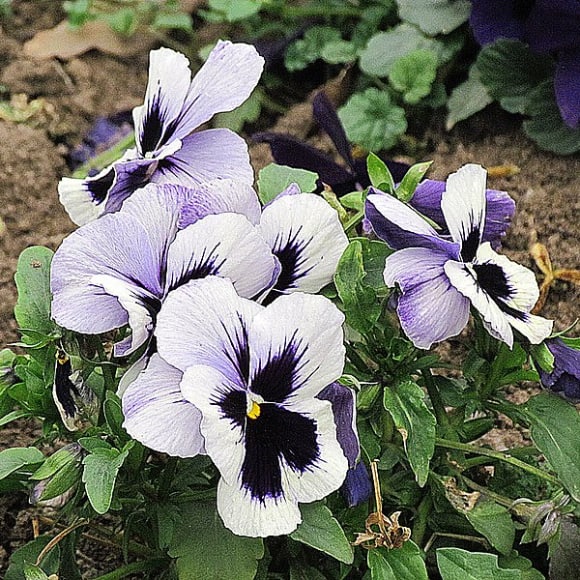
As for this type, it takes two years to complete its life cycle. Biennial plants spend their first year establishing roots, foliage, and food structures. Then spend their second year flowering, producing fruit, and releasing seeds before dying. While the lifespan is short, biennial plants are more cold-tolerant than annual, but not all of them are. If you choose to grow them, plant them in early spring so that they have time to establish their roots. That way, it won’t be too difficult for them to grow when summer comes.
1.3. Perennial Plants
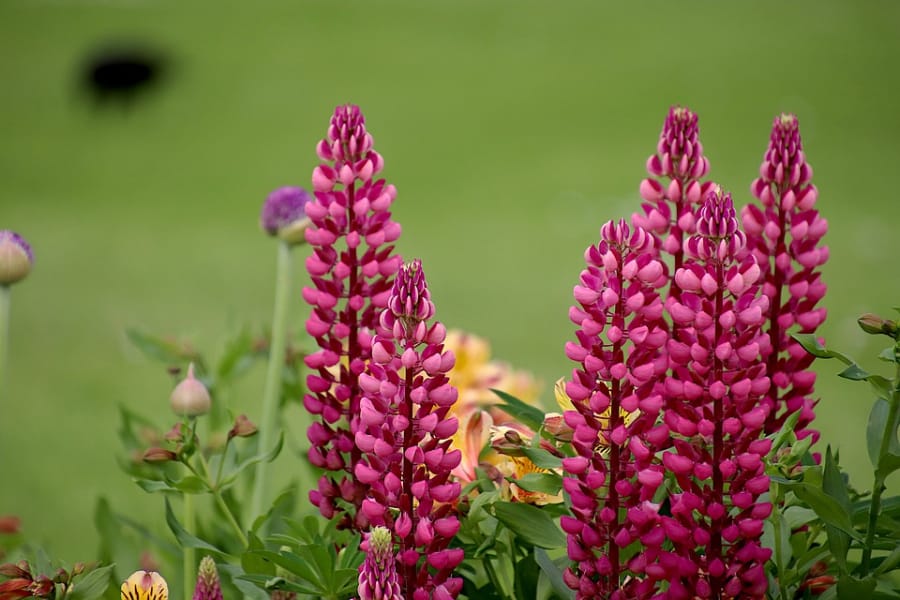
A perennial plant is a plant that can live for up to 3 or more growing seasons, not years, growing seasons. If we talk about years, they can live more than two years which is longer than the two above. This type of plant focuses on its growth below the soil surface during the first two years. That means they dig deep into the ground to create a dense and established root system. This is why perennial plants can handle hard, frosty soil even when winter comes.
What you have to know when growing perennials is that they don’t necessarily bloom during the first year. Once they are familiar with the conditions they are growing in, they will start blooming in the second or third year. And if you can’t wait, it is advisable to plant annuals alongside perennials in your new garden. That way, the annuals can give some blooms and life to your garden before perennials show their beauty. Just like annuals, there are three other categories for perennials which are:
- Hardy: includes tough plants that overwinter in freezing, ice, and snowy conditions. These plants stop growing in winter and they will perk back up in spring.
- Half-Hardy: can withstand freezing temperatures and frost, but is not as cold-tolerant as perennials. Extreme cold can damage them, so they are not suitable for the states up in the far north.
- Tender: grows as evergreens in warm southern climates, but it does not respond well to frost at all.
2. Things To Know Before Starting Flower Gardening
Flower gardening is not just only about digging the earth and putting seeds in. It takes more than that to achieve a landscape full of beautiful and colorful flowers. There are certain things that you should know before you start flower gardening, and you will find them all below. Knowing all of these will be beneficial to your gardening skills in the future, so take a look.
2.1. Basic Care
This is the first thing that you should start to learn when you want to begin flower gardening. Basic care allows you to maintain your flowers with the right methods and techniques for their healthy growth. Depending on the types of your flowers, the basic caring tips are:
- Fertilizer: Feeding the flowers correctly is the way to get them to live healthy and strong as they grow. For annuals, start fertilizing the seedlings by using a complete nitrogen-phosphorus-potassium granular fertilizer or soluble fertilizer that is mixed with water. Fertilization will aid the growth of the flowers during their growing seasons so that they will bloom beautifully.
- Mulch: This is for biennials and perennials, and mulch is quite essential for their growth. Apply organic mulch around the flowers to keep the soil moist and to protect the flower roots. This also provides them with a nutrient boost which is a total plus. You can use a layer of compost, pine needles, or shredded leaves around your flowers. As for the annuals, spreading a light layer of grass clippings will do.
- Prune: Clip the top growth off of biennials and perennials during the growing season to encourage bushy and dense foliage. You should also prune the flowers in order to create space between plants and remove diseased branches or foliage.
- Water: You should water your plants deeply to encourage more long and strong roots. If you do shallow watering, it will cause the roots to stay at the soil surface. Doing so will result in plants drying out, causing them to die during drought.
- Weed: You should weed by hand at least once a week from your garden beds. This is to keep the beds healthy and prevent weed roots from stealing nutrients from your flowers.
2.2. Gardening Zones
Beginners don’t really pay attention to the gardening zones, and that is understandable because not a lot of people talk about it. However, gardening zones play an important role in gardening and plant growth of all types. Introduced by the United States Department of Agriculture (USDA), gardening zones are the hardiness zones that identify how well plants will withstand the temperatures. All plants have a certain temperature range in which they can grow, aka the plant hardiness. This is how you know which plants are right for the states or the areas that you are living in.
There are 13 zones in total, and each zone is ideal for various flowers and plants. For example, sunflowers grow best in zones 4 to 9, which are mostly the states in the upper part of the U.S map. Hardiness zones play an important role in the growth of your plants, and that is why you want to pay attention to them. Always do your research on the hardiness zones of the flowers that you want to grow. That way, this is to ensure that you grow your flowers in the right zones.
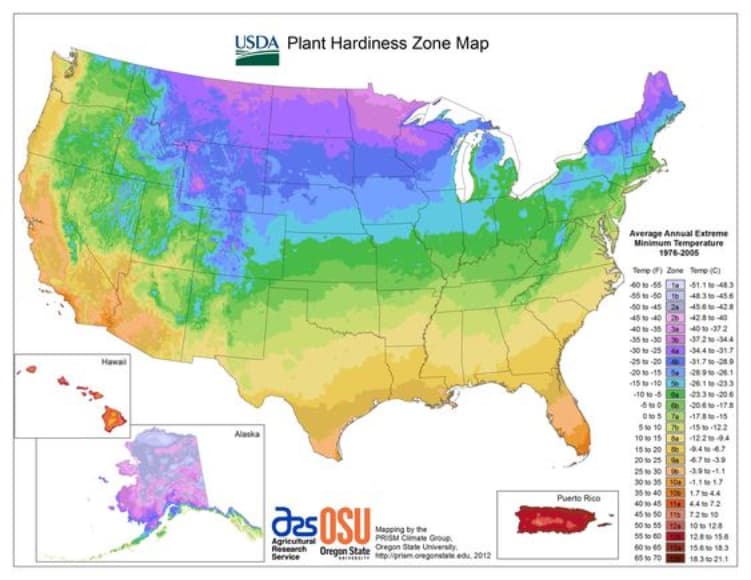
2.3. Seasons
As you probably already know, each flower has its own growing and blooming season. This is also one of the crucial things that you should have in mind when you want to grow flowers. Those include spring flowers, summer flowers, fall flowers, and winter flowers. Some of the beautiful flowers in each season are:
- Spring: anemone, azalea, bleeding heart, casa blanca, lily, daffodil, forsythia, hyacinth, lilac, periwinkle, tree peony, tulip, violet, waxflower, windflower.
- Summer: bellflower, bergamot, blazing star, chrysanthemum, dahlias, daisy, daylily, forget-me-not, foxtail lily, hydrangea, iris, rose, sunflower, tube clematis, yarrow.
- Fall: amaranthus, aster, autumn crocus, black-eyed Susan, freesia, hibiscus, geranium, Japanese honeysuckle, juniper, misty blue, pansy, petunia, statice, viola.
- Winter: calendula, camellia, cosmos, gardenia, Hardenbergia, holly berry, jasmine, lenten rose, orchid, witchhazel, yellow jessamine.
2.4. Soil Types
The gardening zones focus on the temperatures that the flowers can live in, but there’s more. You have to also consider the soil conditions and types in your area before starting your garden flowers. There are actually several soil types, and you will need to choose the flowers that grow well in certain type. The most common soil types are:
Clay Soil
Definitely not the best type of soil to have on your lawn, but at least it is good at holding onto nutrients. Along with that, clay soil is ideal for growing plants that require copious amounts of water. At the same time, you can improve its quality with the right management techniques, so it is not entirely bad. All you need to do is amend clay soil with compost and rich-microbe soil products to improve its organic matter.
The downside is that it compacts very easily while draining very slowly, and it is often too alkaline. With these conditions, the flowers that you can grow in clay soil are bee balm, black-eyed Susan, and goldenrod. These flowers simply prefer sandy soils or are the flowers that are tough enough to handle any soil type.
Loamy Soil
This type of soil is a mixture of clay, sand, and silt that has a fine texture. Loamy soil is ideal for many gardens, lawns, and shrubs, and you’re lucky if you have it in your gardens. The great thing about loamy soil is that it has a great structure for growing various flowers and plants. It has a good amount of drainage, it holds nutrients very well, and it retains moisture which is simply great. Not to mention that it contains high calcium levels, and it is great for stimulating healthy plant growth.
The drawbacks of loamy soil are that it is acidic, and you will need to add nutrients to help the plants thrive. Also, succulents like cacti don’t like loamy soil so choose your flowers and plants that enjoy loamy soil.
Sandy Soil
Not many people like sandy soil because it does not have a lot of benefits for growing plants. In fact, there are very few types of plants that you can grow in sandy soil. The good thing is that you can amend it with fewer fertilizers and some water to make it work. You can also add compost to it to improve its organic matter. What’s not good is that you have to do that on a regular basis which is quite tiring.
This type of soil dries out very quickly during summer, and the nutrients that you put in are washed away during rainfall. Despite all these, there are still some flowers that you can grow in sandy soil. Those are Adam’s needle, blanket flower, butterfly weed, and wormwood. These are the plants that prefer dry soil and can tolerate drought.
Silt Soil
Composed of intermediate-sized particles, silt soil can be tricky to work with if you are a beginner. Silt is very fertile, and it holds nutrients very well, which is beneficial for the flowers. At the same time, silt soil has good water holding capacity, so the flowers won’t be thirsty. The flowers that grow well in this type of soil are Japanese iris, swamp milkweed, yellow iris, and more. These flowers thrive in soggy soil, and they love the water, which is why the soil conditions do not affect them.
The disadvantages of silty soil are that it can become compact and hard, and it often forms a crust. This will result in poor water filtration, so you will need to mix it with compost and other soil microbe-rich products.
2.5. How To Test Soil Type
Look at the texture of the soil when it is wet and dry. Start by taking a small amount of earth in your hand, then wet it. After that, knead it into a paste and roll it between your palm to form a ball. Compare the result with soil types below:
- Clay Soil: rolls into a ball easily, but it might feel rough or have a shiny look on the exterior.
- Loamy Soil: feels gritty and sticky, and that is the sign that it is the perfect soil. However, it will fall apart if you mix it with sand.
- Peat Soil: rolls into a ball but breaks apart easily, and it feels a bit like a sponge.
- Sandy Soil: rolls into a ball without a problem but it feels gritty. In another case, it does not roll into a ball well and still feels gritty.
- Silt Soil: feels silky and slippery, but it will roll into a ball with some work.
2.6. Spacing
One of the top rookie mistakes that beginners have is forgetting to leave enough space between each plant. It always looks so roomy when the flowers are little or when they are still as seeds. People forget that sometimes those tiny plants can grow up to a few feet tall, making the garden looks so crowded. Cramming together in one place is one thing; fighting each other for nutrients from the soil is another thing. This is why you should do your research on your plant growth and leave the planting space accordingly. Remember that it is very easy to grow more flowers when there is more room. However, it is not a fun thing to remove the flowers that have already started blooming because it is too crowded.
2.7. Sun
When it comes to gardening for beginners, the sun is among the factors that must not stray out of your mind. Similar to many factors above, different plants need a different amount of light from the sun to survive. Depending on where you live, the amount of sun that shines in your area also varies. This is why you should consider and pick flowers that can grow healthily in your locations. If we talk about that, there are will 3 major types of plants that you will have to know which are:
Full-Sun Flowers
By full sun, the flowers that belong to this category require at least 6 hours of direct sun per day. The special thing about these flowers is that they are also tolerant of arid and drought conditions besides the sun. Full-sun flowers are perfect as border flowers because they do very well in direct sun. Some of the flowers that are great for borders are aster, bee balm, blanket flower, daylily, lavender, sedum, verbena, etc.
There are also perennials that thrive in arid and dry conditions on top of the full sun. You can grow them in containers, and they are low-maintenance, which is so easy to take care of. If you want to have some of the full-sun perennials, there several flowers that I want to suggest. Those are artemisia, dianthus, hibiscus, hens and chicks, lamb’s ear, miniature rose, and Shasta daisy.
Partial-Shade Flowers
As for this type of flower, it is ideal for a shady garden or yard that does not receive full sun. Simply put, partial-sun flowers are shade-tolerant that you can plant even if there is not enough sunlight. The good thing is that there are quite a number of partial-sun flowers that you can choose from. The beautiful perennials are astilbe, bee balm, bellflower, bleeding heart, forget-me-not, foxglove, hellebore, hydrangea, primrose, Siberian iris, and violet. And if you want to grow partial-sun annual flowers, there are some of them too. Those include alyssum, baby blue eyes, begonia, calendula, cleome, fuchsia, impatiens, larkspur, lobelia, monkey flower, nicotiana, pansy, and wishbone flower.
Shade Flowers
You don’t always need sunlight to grow beautiful and colorful flowers. There are flowers that can still live and produce gorgeous blooms in your shady gardens also. As long as the area has around 3 hours of sunlight a day, these flowers are good to go. You can grow them in your low-light gardens, and their beauty is quite charming. Some of the nicest ones are begonia, Bletilla, coleus, cowslip, epimedium, heuchera, lungwort, rhododendron, toad lily, trillium, and woodland tobacco.
3. Flower Gardening Tips For Beginners
Advice is good, but it is not enough without some useful tips for easy gardening for beginners. For those who are new to this, there are a few helpful pieces of advice, along with tips and tricks, below. Note them down, and flower gardening will be less difficult for you, at least.
- Before anything, choose a good location for your flower garden. Usually, more sun means more blossoms because most flowers out there need sunlight to grow. Observe the spot that gets at least 6 hours of sunlight, and that will be an ideal spot for your flower garden.
- A good location is the first step, and the second step will be the soil quality. Because beginners don’t have a lot of experience with mixing soil, it is advisable to invest in nutrient-rich and well-drained soil. When your soil is nutritious, your flowers will have a higher chance of growing beautifully, too.
- Once you have both the location and the soil, it is time to think about the right flowers to grow. It is important to select the plants that suit your growing conditions, like soil, sunlight, zones, etc. There are so many types of flowers that you can choose from; all you need is to pick the right ones. It is always a good idea to start with easy plants that will give you more experience before moving to the next level.
- After that, select the date that you will plant your flowers. This depends on the type of your flowers as well. For example, the best time to plant spring-blooming flowers is in fall because they will have time to establish their roots. Then they will go dormant for the winter before blooming as spring approaches.
4. Helpful Gardening Equipment & Tools
Alongside the tips and tricks, you also need the best gardening tools for your flower gardening projects. You may already know many of the tools that you are going to see below. I still list them down so that you know what you should get right away. Just a few of them, and your first flower gardening experience is going to be fun.
4.1. Fork
A fork is among the must-have hand tools that every gardener should get. It is very useful as you can use it for loosening and transplanting the soil, spreading and turning mulch, and weeding. More than that, it has the maneuverability that allows you to work around delicate plants and smaller stems which is great. A good gardening fork must be durable and tough, so it should be made from stainless steel. This will also prevent it from rusting while making it strong enough to penetrate the soil. Make sure to choose a garden fork with an ergonomic grip so that it is comfortable to use.
4.2. Gardening Apron
You will need to have a gardening apron if you don’t want to carry gardening tools in containers. A gardening apron comes with multiple specific compartments or pockets that you can use to store your gardening tools. On top of that, the apron also protects your clothes from dirt during your gardening activities as well. When you buy gardening aprons, look for the ones that are durable as well as easy to wear. There should be as much storage space as possible so that you can carry all the important tools in one go.
4.3. Gardening Cart
Gardening carts are very useful in gardening, and here is why. You can easily transport fertilizer, mulch, soil, and other items from one place to another without breaking a sweat. It can handle many things in one, and it comes in handy when you have items to harvest from the garden. The important features to focus on in a gardening cart are the handle, storage size, and wheels. Its handle should be comfortable and ergonomic, the storage size should be roomy, and the wheels should be durable. Once the gardening cart has all three, then you can use the cart for years to come.
4.4. Gardening Gloves
So why should you wear gardening gloves? Gardening gloves all you to handle your flowers and plants without worrying about getting your hands dirty. At the same time, they also protect your hands from bacteria and fungi that can potentially cause you harm. Along with that, these gloves can even protect your hands from cuts or injuries caused by sharp gardenia tools. When buying gardening gloves, choose the ones that are breathable, comfortable, flexible, and water-resistant with a non-slip grip. That way, you will be able to use them for gardening, landscaping, weeding, and more with great comfort.
4.5. Garden Tool Set
Or, if you don’t want to go through the hassle of ordering things one by one, just get a garden tool set instead. Purchase once, and you will have all the gardening tools that you need, which is so convenient. Most garden tool sets include all the essential gardening tools along with additional items like an apron, gloves, and more. More than that, they all come in a bag where you can easily store everything in place neatly. Not to mention the reasonable price, maybe this could be something that you want to go for.
5.6. Trowel
So handy to have, you can use a trowel for digging, planting, mixing soil, removing stubborn weeds, transplanting, and more. It is so small, which is so convenient to use, and it is also quite functional as well. Besides gardening, you can also use a trowel for other outdoor activities that require digging. The best trowel should be durable and rust-resistant, and its handle should be comfortable and easy to grip. I highly recommend buying them in a bundle with a few other useful gardening tools; they come at a great price.
4.7. Watering Can
You know this is something that you need to have no matter what kind of garden you grow. There are various types of watering cans, such as metal, plastic, resin, and more. The key is to choose the ones that can store enough water for you to water your flowers. It should be easy to clean and store, and the spout should be long enough for deep watering. The good thing is that the choices for watering cans are endless; the decision is all yours to make.
4.8. Weeder
Weed is inevitable, and this is why you need a weeder, although it is just the beginning of your flower gardening journey. A weeder allows you to weed flower beds and other small vegetable gardens with ease. It comes in a compact size that fits nicely in your hand to make it easy for you to maneuver. When you buy a weeder, make sure that it is durable and sturdy so that it can remove weeds well. It might look strange, but it is very easy to use. The video below will show you how to use a weeder, so take a look.
Bonus: Garden Tool Organizer Belt Bag
In case you don’t want to wear an apron, this is the alternative that you might like. A garden tool organizer belt bag is like a fanny pack for your necessary gardening tools. It is more compact and lighter, and it has quite plenty of room also. You can also double as a waist bag for other items due to the convenient compartments.
5. 10 Easy Flowers For Gardening
We all want to grow attractive and pretty flowers, but you should think twice if you are a beginner. Some flowers have more growing requirements than others, making things more complicated for people without flower gardening experience. This is why I want to introduce to you some of the flowers that are easy to grow in your garden. I made sure to select just the gorgeous ones; maybe you like one or two of them.
5.1. Coneflower
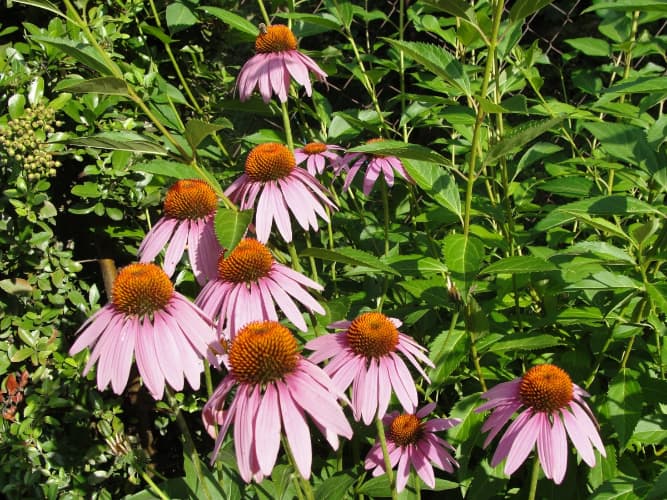
- Colors: Bicolor, Orange, Pink, Purple, White, Yellow
- Height: Up to 6 feet
- Zones: 3 – 9
Things never go wrong when you grow flowers of various color options like this one right here. There are so many colors to choose from, and you can grow all color varieties in the garden as well. What many garden flower owners love about coneflowers is the fact that they bloom for months. Plus, with the fact that these drought-tolerant plants attract birds and pollinators, they are great choices to have. Coneflowers grow well in rich and well-drained soil, and you can plant them in full sun.
5.2. Dahlias

- Colors: Orange, Pink, Purple, Red, White, Yellow
- Height: 1 – 6 feet
- Zones: 7 – 10
What’s special about dahlias is that this flower thrives in most climates, so growing them is quite convenient. You can plant them in full sun, and they grow well in sandy and well-drained soil. Another awesome thing about these flowers is that they come in a wide range of shapes. From anemone and double to pompon, single, and spiky, dahlias are available in them all for you to choose from. They only need water a few times a week, and maintenance is so easy with these beautiful flowers.
5.3. Dianthus
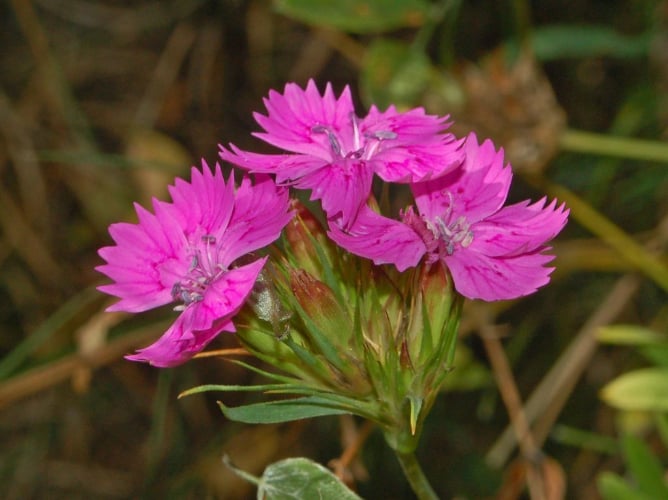
- Colors: Pink, Purple, Red, White
- Height: 10 – 20 inches up to 3 feet
- Zones: 3 – 9
Here we have an attractive evergreen green foliage that has showy, fragrant flowers of clove scent. The flowers of dianthus bloom from May to August, and their colors are very gorgeous. You can grow them in full sun to light shade, and they do very well in well-drained soil. One of the great things about these flowers is that they are deer-resistant. That way, you won’t have to worry much about damage from pests at all.
5.4. Lavender

- Colors: Lavender, Pink, Purple, White
- Height: 20 – 24 inches
- Zones: 4 – 9
Lavender is one of the easiest flowers to grow, and you can have them in many different areas. Just make sure to plant them in full sun and well-drained soil, and you are good to go. These flowers are drought-tolerant, so you can water them infrequently but make sure to water them deeply. Apart from being so easy to grow and looking great, lavenders can also repel mosquitos and bugs, which is awesome.
5.5. Marigold
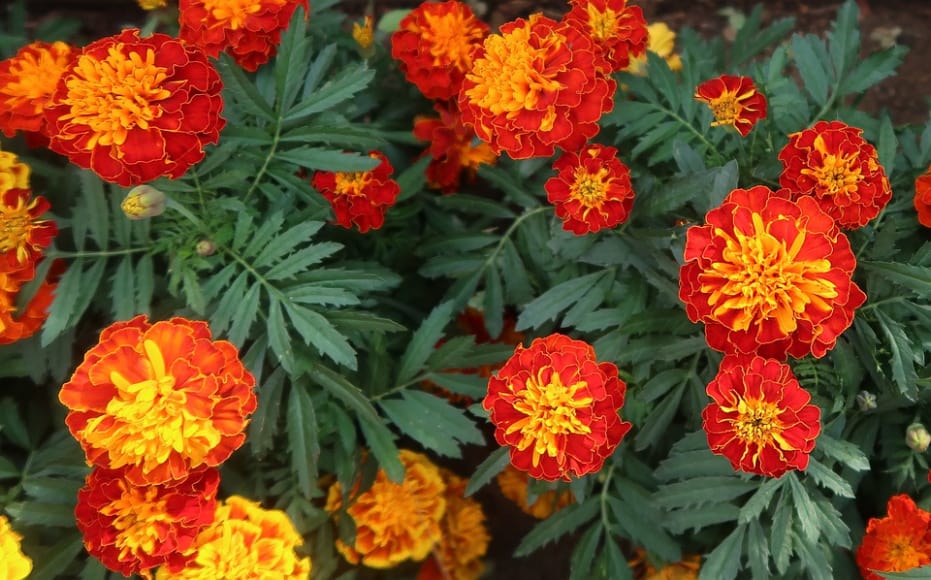
- Colors: Gold, Red, Yellow
- Height: 6 inches – 3 feet
- Zones: Annual
Want some flowers that grow fast from seed? Then you want to consider growing marigolds; these flowers are absolutely incredible to have. They bloom in spring, summer, and fall, and you can plant them in full sun without a problem. This beautiful flower grows in dry or sandy gardens, but they prefer well-drained soil if possible. Besides their beauty, marigolds even help to repel mosquitos which is a total plus.
5.6. Snapdragon
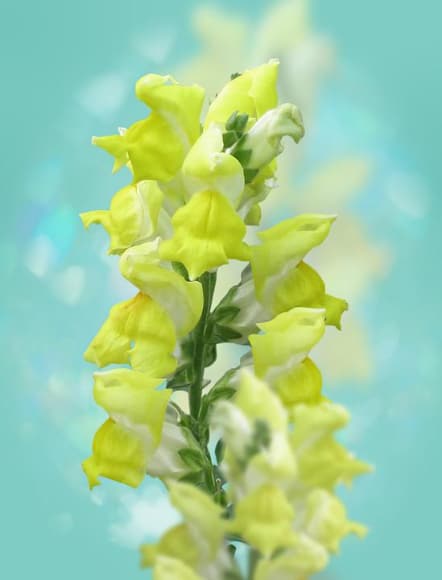
- Colors: Orange, Red, Peach, Pink, Purple, Violet, White, Yellow
- Height: 6 – 15 inches
- Zones: Annuals, Zone 5 – 10 As Perennials
Start growing snapdragons in your garden if you want to attract butterflies; they are very good at doing that. Snapdragons are gorgeous flowers that bloom from spring through fall as well as in cool summer growing conditions. It is best to grow them in full sun, in well-drained soil, and water their base regularly. You should grow the varieties of their colors in your garden, and they just complement each other beautifully for you.
5.7. Sunflower

- Colors: Brown, Yellow, Mixed
- Height: 3 – 16 feet
- Zones: Annual
We all know sunflowers, and we know how stunning they are. Sunflowers thrive in full sun, and they tolerate most soil types except water-logged ones. These gorgeous flowers bloom during the summer, and they are drought-tolerant and heat-tolerant, which makes them so easy to grow. Not to mention that sunflowers attract bees, butterflies, and birds; having them in the garden is just amazing.
5.8. Sweet Peas
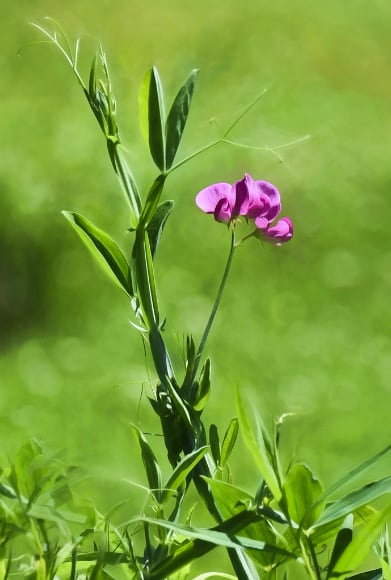
- Colors: Blue, Pink, Purple, Red, White
- Height: 3 – 8 feet
- Zones: Annual
Although appearance is not as attractive as most blooms, sweet peas have their own special features for you. They are highly fragrant flowers that show off their beauty starting spring through early summer and into fall. Quite hardy for small flowers that need a supportive fence or trellis to grow hey? Make sure to grow them in full sun and in loamy, well-drained soil, and keep them moist. A friendly reminder, their seeds resemble edible sweet peas, but they are toxic if you eat them, so avoid doing that.
5.9. Wax Begonias
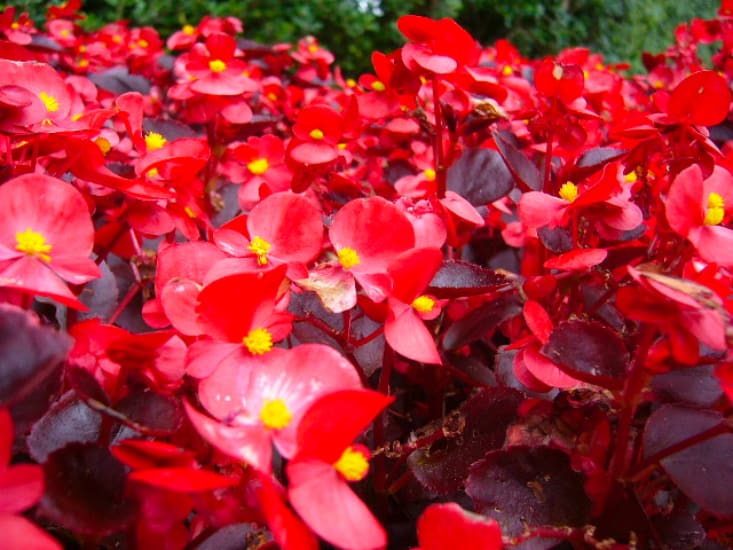
- Colors: Orange, Pink, White, Yellow
- Height: 6 – 12 inches
- Zones: Annuals, Zone 10 – 11 As Perennials
What makes wax begonias stand out is that there are varieties that produce single or double blooms. Their flowers are either ruffled or smooth petals, and their colors make them even more attractive to have in the garden. Snapdragons grow best in partial sun to shade, and they are quite easy to care for. The unique thing about growing them is that they require fertile, amended soil to grow in. At the same time, you will also need to water them consistently.
5.10. Zinnias
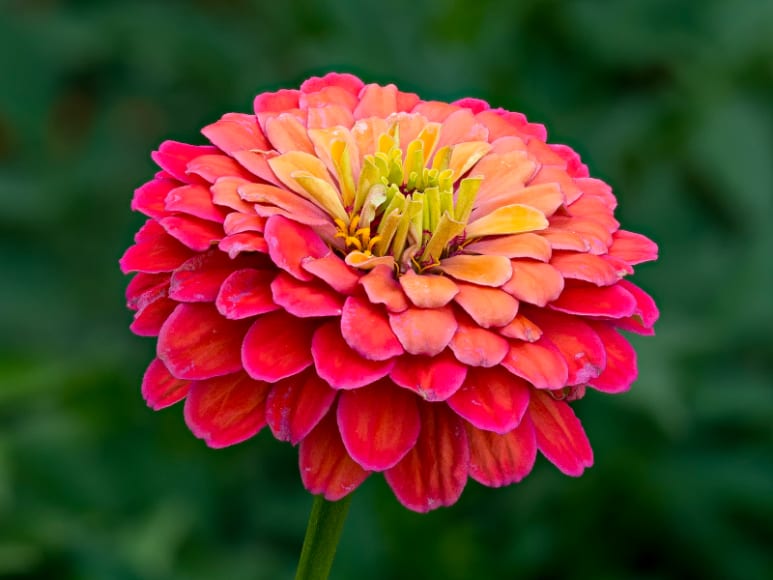
- Colors: Orange, Pink, Shades Of Red, White, Yellow
- Height: 20 – 24 inches
- Zones: Annual
Flowers that look like this one are extremely gorgeous, and they are also available in various shapes too. Zinnias flowers bloom in the summer months, and they attract butterflies to your garden when they do. You can easily grow them in rich and well-drained soil, and they are very easy to care for. These gorgeous flowers have moderate water requirements, and they grow best in full sun.
Wrap Up
Well, that was a lot of things to cover, but at least I know I included all the important tips. Flower gardening can be quite challenging at first, but you will get a hold of it after some time. Just don’t give up, don’t pressure yourself, and keep doing more research because things will only get better. Since I even include the easy flowers for gardening, maybe you can try starting with those. Don’t forget to share your results with me; I am keen to hear about your experience.
